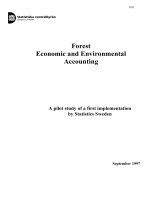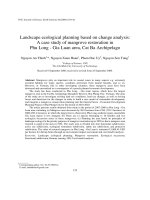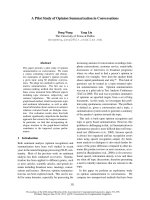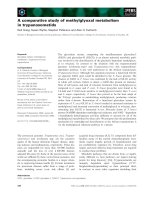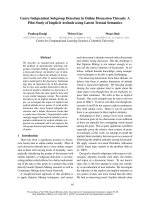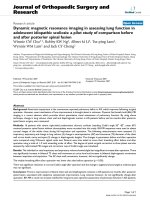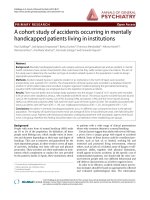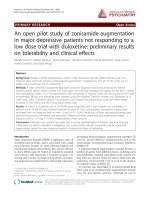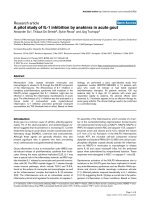Weather Index-Based Rice Insurance A Pilot Study Of Nine Villages In Zhejiang Province, China
Bạn đang xem bản rút gọn của tài liệu. Xem và tải ngay bản đầy đủ của tài liệu tại đây (528 KB, 90 trang )
Weather Index-Based Rice Insurance
A pilot study of nine villages in Zhejiang Province, China
Master’s Thesis
Management, Technology and Economics (MTEC)
By
Yuting Chen
Supervisors at ETH Zurich
Prof. Dr. Didier Sornette (Chair of Entrepreneurial Risks)
Prof. Dr. Bernard Lehmann (Agri-Food & Agri-Environmental Economics Group)
Dr. Raushan Bokusheva (Agri-Food & Agri-Environmental Economics Group)
June 2011
Acknowledgement
I am a Chinese student who has been living in Switzerland for four years. Only after I started
to live and study in a new country, did I realize that how important my home country means
to me and how little I knew about it. During all these years, I have carefully studied my home
country, and tried to acquire a clear perspective of the current Chinese society. As you may
read from a quotation of Confucius “A superior person cares justice and morality, while a
villain keeps his mind only on benefits”, the ancient Chinese culture values justice and
morality and abhors selfishness. However, after the reforming and opening-up policy was
issued in 1992, the whole nation’s attention was drawn to the fast cumulated wealth and the
nouveau riche in this land. While thousands of years’ of traditional virtues were gradually
abandoned, money worship has grown to dominate the present Chinese society. The gap
between the rich and the poor is becoming surprisingly large year by year. This situation
could be depicted by a famous Chinese poem as “The rich’s wine and meat are left to rot,
while the poor die frozen on roads”.
The Chinese society has become so unevenly structured that I feel I am obliged to do
something to help those disadvantaged and poor people. This is the reason why I choose
China’s agriculture insurance as my research topic. There are more than 0.7 billion farmers in
China, earning an average annual income of about US$ 750 per capita in 2009, which is less
than 1/3 of the urban dwellers’ income. The farmers are the largest group of poor and
disadvantaged people in China. It would be meaningful to me if my research result could be
used to help these farmers, and to help the society to become more harmonious.
Given my lack of experience, I met with some problems in the process of my thesis. However,
I am very thankful that I have my supervisors, teachers and many other friends to help me to
overcome the difficulties and finally finish the thesis.
First, I would like to thank my supervisor, Dr. Raushan Bokusheva at Agri-Food &
Agri-Environmental Economics Group of Swiss Federal Institute of Technology. Her
expertise on agri-economics guided me through the whole process of my Masters thesis. I
really appreciate her prompt response and helpful assistant especially when I met with serious
data problems and a rapidly approaching thesis deadline. At the same time, I also would like
to thank Prof. Bernard Lehmann at Agri-Food & Agri-Environmental Economics Group of
Swiss Federal Institute of Technology. His support enabled me to write this thesis with Dr.
Raushan Bokusheva.
I also would like to specially thank my supervisor, Prof. Didier Sornette at the Chair of
Entrepreneurial Risks at the Department of Management, Technology and Economics of
Swiss Federal Institute of Technology. I appreciate his advices and patience during the whole
period of my thesis.
II
I would like to thank Dr. Bing Wang for her kindness of sharing valuable information with me
for my master thesis.
Another thanks goes to Prof. Frank Schweitzer and Ms. Natalie Aeschbach-Jones for granting
me an extension of the deadline of my thesis and helping me through the administration
process.
Additionally, I want to express my thanks to Dr. Weimin Dong, Prof. Pane Stojanovski, and
many others who encouraged and instructed me during my internship at RMS, where I started
my Master thesis.
Finally, I would like to thank my family and friends for their continuing support during my
master thesis. I really appreciate Fintan’s help and care especially in the last two months of
thesis writing.
III
Abstract
This Masters thesis presents the results of a pilot scale study on weather index-based rice
insurance in Zhejiang province, China. The goal of this thesis is to find the best suited
weather index-based rice insurance model for each rice cropping zone of Zhejiang. By testing
a wide range of weather indexes for their relationship with the rice yield per unit land in each
rice cropping zone using classic regression models, a set of weather indexes were selected for
each rice cropping zone of Zhejiang. A rice insurance product was then designed based on the
relationship between the chosen weather index and rice yield. Basis risks were studied in
detail in this thesis, and were reduced in the insurance model by defining the insurable
farming scale to rice cropping zone and by removing the time trend in rice yields. The results
show diversified features in weather index and insurance product design of different rice
cropping zones in Zhejiang.
Key words
Weather index, rice insurance model, rice cropping zone, Zhejiang
IV
Table of Contents
Page
Acknowledgement…………………………………………………………………………… ii
Abstract ……………………………………………………………………………………. . iv
Table of Contents…………………………………………………………………………….. v
List of Figures…………………………………………………………………………….…. vii
List of Tables…………………………………………………………………………….…… ix
Chapter
1 Introduction…………………………………………………………………………….….1
1.1 The goal of this thesis…………………………………………………………….…...1
1.2 Thesis structure…………………………………………………………………….….1
1.3 The importance of agriculture insurance in China………………………………….…2
1.4 Agriculture insurance in China…………………………………………………….….3
1.5 Zhejiang province………………………………………………………………….….5
2 Methodology………………………………………………………………………….…...8
2.1 Definitions……………………………………………………………………….….....8
2.2 Weather index-based agriculture insurance……………………..……………….….. 10
2.2.1 Introduction………………………………………………………….…..…….. 10
2.2.2 Research object…………………………………………………….…..……… 11
2.2.3 Methodology of modeling……………………………………….…..……….....13
2.2.3.1 Reducing the basis risks……………………………….…..…………...13
2.2.3.2 Detrending rice yield per unit land………………….…..………...…...19
2.2.3.3 Weather index design……………………………….…..……………...21
2.2.3.4 Weather index and rice yield relationship model design………….…...26
2.2.4 Insurance product design……………………………………….…..………......27
3 Data Analysis………………………………………………………….…..……..……… 30
3.1 Data sources and quality………………………………………….…..……..………. 30
3.2 Removing trend in rice yield…………………………………….…..……..………... 30
3.2.1 Time trend………………………………………….…..……..……………….. 30
V
3.2.1.1 Time trend and rice yield………………….…..……..……………….. 31
3.2.1.2 Time trend and other quantitative non-weather factors…………...….. 32
3.2.2 Other non-weather factors………………………….…..……..……………..... 33
3.2.3 Detrending rice yield per unit land………………….…..……..…………….... 34
3.2.3.1 Time trend…………………………….…..……..……………………. 34
3.2.3.2 Time trend or education trend? ……….…..……..…………………….41
3.2.3.3 Adjusted Rice Yield………………….…..……..……………………...41
3.3 Weather index design…………………………….……..……..…………………….. 42
3.3.1 Weather index selection…………………….……..……..……………………. 42
3.3.2 Relationship between adjusted rice yield and weather index…………………. 43
3.3.3 Discussion…………………………….……..……..………………………….. 56
3.4 Insurance product design………………….……..……..…………………..……….. 57
3.4.1 Rice price…………………………….……..……..…………….…………….. 57
3.4.2 Indemnity…………………………….……..……..…………….…………….. 57
3.4.3 Pure premium……………………….……..……..…………….……..……….. 58
3.4.4 Risk premium……………………….……..……..…………….……..……….. 61
3.4.5 Discussion…………………………….……..….....…………….…………….. 63
4
Conclusion and Discussions…………………….……..….....…………….……...…….. 65
4.1 Results and conclusions…………………….……..….....…………….……...…….. 65
4.2 Novelty of this study…………………….……..….....………………..……...…….. 66
4.3 Problems in this study…………………….……..….....…………….……......…….. 68
4.4 Proposals for future works……………….……..….....…………….……......….….. 70
Appendix…………………….……..….....…………….……......………………………….. 72
Appendix I Patterns in climate change.....…………….……......………………..………….. 72
Appendix II Agriculture insurance policies in Zhejiang…......………………..……………. 75
References………………….……..….....…………….……......………………………..….. 76
VI
List of Figures
Chapter 1
Figure 1.1 China Agricultural Insurance Premiums 2004-2009
Figure 1.2 Total Numbers of Agricultural Insurance Companies in China 2004-2009
Figure 1.3 Location of Zhejiang Province in China
Figure 1.4 Landscapes of Zhejiang
Chapter 2
Figure 2.1 Area Proportion of Single and Double Cropping Rice in Zhejiang 1993-2004
Figure 2.2 Map of Target Villages and Weather Stations in Zhejiang
Figure 2.3 Topographic Map of Target Villages and Weather Stations in Zhejiang
Figure 2.4 Area Percentages of Inbred Rice and hybrid Rice in Zhejiang
Figure 2.5 Rice Cropping Area in Zhejiang 1993-2003
Chapter 3
Figure 3.1 Per Unit Area Rice Yield in Zhejiang 1986-2003
Figure 3.2 Per Unit Area Rice Yield in Zhejiang With Outliers Removed 1986-2003
Figure 3.3 Zone 1 Per Unit Land Rice Yield with Time Trend’ Regression Line
Figure 3.4 Zone 2 Per Unit Land Rice Yield with Time Trend’ Regression Line
Figure 3.5 Zone 3 Per Unit Land Rice Yield with Time Trend’ Regression Line
Figure 3.6 Zone 4 Per Unit Land Rice Yield with Time Trend’ Regression Line
Figure 3.7 Zone 5 Per Unit Land Rice Yield with Time Trend’ Regression Line
Figure 3.8 Zone 6 Per Unit Land Rice Yield with Time Trend’ Regression Line
Figure 3.9 Quadratic Regression of Zone 6 Per Unit Land Rice Yield with Time Trend
Figure 3.10 Rice Yield Per Unit Land Deviation from Time Trend’ Detrending Function
Figure 3.11 Linear Regression of Zone 1 Adjusted Per Unit Land Rice Yields with Average
Maximum Temperature in Rice Growth Period
Figure 3.12 Quadratic Regression of Zone 1 Adjusted Per Unit Land Rice Yields with Average
Maximum Temperature in Rice Growth Period
Figure 3.13 Linear Regression of Zone 2 Adjusted Per Unit Land Rice Yields with Highest
Monthly Precipitation in Rice Growth Period
Figure 3.14 Quadratic Regression of Zone 2 Adjusted Per Unit Land Rice Yields with Highest
Monthly Precipitation in Rice Growth Period
Figure 3.15 Linear Regression of Zone 3 Adjusted Per Unit Land Rice Yields with Average
Wind Speed in Rice Growth Period
Figure 3.16 Quadratic Regression of Zone 3 Adjusted Per Unit Land Rice Yields with Average
Wind Speed in Rice Growth Period
Figure 3.17 Linear Regression of Zone 4 Adjusted Per Unit Land Rice Yields with Highest
Monthly Precipitation in Rice Growth Period
Figure 3.18 Quadratic Regression of Zone 4 Adjusted Per Unit Land Rice Yields with Highest
Monthly Precipitation in Rice Growth Period
Figure 3.19 Linear Regression of Zone 5 Adjusted Per Unit Land Rice Yields with Average
VII
Wind Speed in Rice Growth Period
Figure 3.20 Quadratic Regression of Zone 5 Adjusted Per Unit Land Rice Yields with Average
Wind Speed in Rice Growth Period
Figure 3.21 Linear Regression of Zone 6 Adjusted Per Unit Land Rice Yields with Highest
Monthly Precipitation in Rice Growth Period
Figure 3.22 Quadratic Regression of Zone 6 Adjusted Per Unit Land Rice Yields with Highest
Monthly Precipitation in Rice Growth Period
Figure 3.23 Zone 4 Ajusted Rice Yield with Highest Monthly Precipitation when Regressor
Parameter Varies within ±σ
Figure 3.24 Zone 5 Ajusted Rice Yield with Average Wind Speed when Regressor Parameter
Varies within ±σ
Figure 3.25 Zone 6 Ajusted Rice Yield with Highest Monthly Precipitation when Regressor
Parameter Varies within ±σ
VIII
List of Tables
Chapter 2
Table 2.1 Growing Stage Periods for Double and Single Cropping Rice
Table 2.2 Number of Annual Newly Validated Rice Breeds in China and in Zhejiang
Table 2.3 Area Proportions of Single Cropping Rice and Double Cropping Rice in Each Rice
Cropping Zone of Zhejiang in 2004
Table 2.4 Temperature Requirements of Rice
Chapter 3
Table 3.1 Correlation between Per unit Area Rice Yield and Time Trend
Table 3.2 Correlation between Time Trend and Other Non-Weather Factors
Table 3.3 Correlation between Fixed Assets of Large and Medium Production Tools and Per
Unit Land Rice Yield
Table 3.4 Correlation between Farming Labor Factors and Per Unit Land Rice Yield
Table 3.5 Correlation between Per Unit Land Rice Yield Deviation and Time Trend-Predicted
Rice Yield
Table 3.6 Correlation between Per Unit Land Rice Yield Deviation from Time Trend and
Educational Level of Each Zone
Table 3.7 The Adjusted Annual Rice Yields of Zhejiang Based on Year 2003 (ton/ha)
Table 3.8 Correlation between Weather Indexes and Adjusted Per Unit Land Rice Yield from
Time Trend
Table 3.9 List of Weather Indexes Chosen for Each Zone
Table 3.10 Function Chosen for Each Rice Cropping Zone in Zhejiang
Table 3.11 Rice Price of Each Rice Cropping Zone in Zhejiang
Table 3.12 Strike Level K for Rice Cropping Zone 4-6 of Zhejiang
Table 3.12 Indemnity Amount for Weather Index-based Rice Insurance Contract in Rice
Cropping Zone 4-6 of Zhejiang
Table 3.13 Zone 4 Annual Rice Yield Loss Calculation Results
Table 3.14 Zone 5 Annual Rice Yield Loss Calculation Results
Table 3.15 Zone 6 Annual Rice Yield Loss Calculation Results
Table 3.16 Pure Premium for Weather Index-based Rice Insurance Contract in Rice Cropping
Zone 4-6 of Zhejiang
Table 3.17 Weather Index-based Rice Insurance Contract Design in Rice Cropping Zone 4-6
of Zhejiang
Table 3.18 Hedging Efficiency of the Weather Index-based Rice Insurance Model
Table 3.19 Change of Average Annual Yield Loss when Regressor Parameter Varies within
±σfor Zone 4-6
Chapter 4
Table 4.1 The Insurability of Weather Index-based Rice Insurance for Each Rice Cropping
Zone in Zhejiang
Table 4.2 Weather Index-based Rice Insurance Contract Design for Zone 4-6 in Zhejiang
IX
Chapter 1
Introduction
1.1 The Goal of This Thesis
Agriculture insurance is recognized as a robust economic tool to minimize the economic
impact of natural disasters and to protect farmers’ interests. In China, relatively simple
agriculture insurance models have been practiced in the past, however these traditional
agriculture insurance models fail to offer the farmers adequate protection from natural
disasters such as the severe drought in Yunnan in March 2010. More advanced and
comprehensive agriculture insurance models tailored to each agricultural region are required.
Weather index-based agriculture insurance models have been developed to overcome the
effects of adverse selection and moral hazard in traditional insurance models; and such
weather index-based insurance models are now being experimented with in China.
The aim of this Masters thesis is to identify a suitable weather index-based rice insurance
model for Zhejiang province. Rice production data was collected from 9 villages in Zhejiang
as a pilot scale program. Zhejiang is one of the most developed provinces in China, with a
prosperous economy, highly educated population and good weather recording facilities.
Additionally, Zhejiang is located in an area at high risk of typhoons as well as other extreme
weather events such as rainstorms or autumn droughts. At present, the agriculture insurance
penetration rate in Zhejiang is still at a low level, with a total indemnity of 52.54 million Yuan
(about US$8.1 million) during 1996-2004 [1]. Thus, there is a great potential for a well
developed weather index-based agriculture insurance to be introduced into the insurance
market in Zhejiang which would protect the local farmers from severe income losses as a
result of extreme weather.
The results of this pilot initiative presented in this thesis may be taken as a reference for
further studies that would look to provide a more comprehensive and integral weather-based
rice insurance products for Zhejiang in the future.
1.2 Thesis Structure
This master thesis composes of four main chapters – Introduction, Methodology, Data
Analysis, and Conclusions.
Chapter 1 is an introduction to weather-indexed agriculture insurance specifically as it applies
to Zhejiang. Firstly the goal and structure of this thesis is provided, followed by the
importance of agriculture insurance at national and provincial level.
Chapter 2 provides an explanation of the methodology of weather index-based agriculture
insurance modeling in Zhejiang tailored to rice cropping conditions in this region. Definitions
of terms are introduced first, and different modeling methods are then depicted and discussed.
1
This chapter provides the theoretical basis for the data analysis in the following chapter.
Chapter 3 presents the analysis of rice yield data and builds weather index-based rice
insurance model for Zhejiang. A detailed analysis is performed followed with discussions of
the limitations of the model. A localized weather index-based rice insurance product is then
designed based on the results of weather-based insurance modeling.
Chapter 4 contains the conclusions of the weather index-based rice insurance modeling and
insurance contract design. The novelty and problems of this insurance design are pointed out,
and some suggestions for future works on this issue are proposed in the end.
1.3 The Importance of Agriculture Insurance in China
China is one of the world’s largest agricultural producers. Agriculture accounts for 11% of
China’s total GDP, and the sector engages 41% of the total labor force, according to a report
from WFP and IFAD [2]. Although China is the fourth biggest country by total arable area in
the world, its per capita arable land is only 29.6% of the world’s average level in 1999 [3].
The arable land has continuously decreased in the last 40 years as a result of rapid economic
development. According to the survey of the State Administration of National Land, an
average of 466,700 ha arable land was taken for non-agricultural construction every year
during the years from 1986 to 1995 [3]. (The State Administration of National Land is
responsible for formulating, execution and implementation supervision of national land
policies and regulations.) The population of China is also increasing with an annual rate of
0.6% over the latest 10 years [4] and coupled with decreasing arable land, agriculture is
becoming one of the most critical issues facing China today.
Chinese farmers are already amongst the poorest in the society with an annual per capita net
income of US$715 in 2008, while annual per capita net income of urban dwellers was
US$2370 [5]. The gap between the rich and the poor is becoming surprisingly large in China
and even growing. “The wealthiest 0.4 percent of households in China own more than 60
percent of the country’s total personal wealth” (The Boston Consulting Group Report, 2006)
[6].
The enlarging gap of wealth between the poor and the rich indicates that the majority of the
farmers have not benefited from the economic development in China over the last decades.
The Chinese government has recognized the importance of agriculture for its economy and
for the social stability of the country. The Chinese central government published an official
document known as a “No.1 Central Document” each year from 1982 to 1986, and from 2004
to 2010, and all were focused on agricultural issues in China [7]. (No.1 Central Document is
the first document issued by the Chinese central government every year with fundamental
guiding importance. The issues mentioned in this document are the most urgent problems for
China of this year.) The regular publication of such documents reveals the focus of the
Chinese government on its agricultural industry.
2
1.4 Agriculture Insurance in China
Farmers have been given a high priority on the government agenda since 2004, when Chinese
government re-emphasized the importance of agriculture in the “No.1 Central Document”. A
new Chinese agricultural subsidy system was established in 2004 to directly subsidize farmer
in order to protect their interests [8]. One of the measures taken to subsidize farmers was by
reducing agricultural tax. The Chinese government has gradually cancelled agricultural tax
which has been imposed for more than two thousand years, and it was totally abolished in
2006 with the release of “Decision on the Abolition of Agriculture Ordinance” by the
Standing Committee of the National People's Congress [8].
Another important measure taken by the government to protect farmers’ interests is
agricultural insurance subsidy, which was driven by Chinese Insurance Regulatory
Commission (CIRC) from 2004. In 2007, the State Council approved a 1 billion RMB Yuan
fund for agriculture insurance subsidy in six provinces-Jilin, Sichuan, Hunan, Neimenggu,
Xinjiang and Jiangsu. Central and provincial government paid around 50% of the premium,
city and county government paid 10%-30%, and the rest were paid by the farmers. The
premium rate varies from 3% to 10% according to regions, crops, and perils. Several natural
disasters were covered: rainstorm, flood, windstorm, hail, and drought, and several diseases in
crops and livestock, etc. Unfortunately, the insured amount was low and did not fully cover
loss of earnings [9].
China’s total agricultural insurance premium has increased 28-fold, from 466.95 million Yuan
(about US$72 million) in 2004 to 13297.5 million Yuan (about US$2046 million) in 2009
[10-14] (See Fig. 1.1). Year 2006 was the starting point of the rapid growth, probably due to
the planned launch of State Council’s six province agricultural insurance subsidy policy in
2007. The number of insurance companies in this field also increased from 3 in 2004 to 21 in
2009, which is a 7-time growth (See Fig. 1.2) [10-14]. The inflation rate compared to year
2010 is also calculated in the data.
3
Figure 1.1 China Agricultural Insurance Premiums 2004-2009 [10-14]
Figure 1.2 Total Numbers of Agricultural Insurance Companies in China 2004-2009 [10-14]
Although the agriculture insurance industry has been booming in China in recent years, the
agriculture insurance policies in China still remain to be the traditional damage-based
insurance, which exposes the farmer to the risk of serious problems such as adverse selection,
moral hazard, low efficiency of indemnity after disasters, high transactional costs, and large
damage assessment errors. This may have, to some extent, hampered the development of the
agriculture insurance industry in China. [15] China performed initial agriculture insurance
experiments in 1934, but since this time theoretical research into agriculture insurance has
remained at a rather low level, with few successes translated into practice. [16] In a Swiss Re
Focus report in 2008 it was stated that “It remains a challenge to create a robust agriculture
insurance market for different climatic regions and various small-scale farming operations in
4
China. As in other emerging markets, a lack of historical loss data, limited access to farmers
and little to no knowledge about insurance products among the wider population are also
important issues.” [17] “Premium rates for the national agriculture insurance programs are
negotiated between the insurers and provincial governments. The insurance premiums and
policy terms and conditions are usually uniform within a province, and hence do not represent
the variations of risk factors within a province.” [17]
“There are several traditional crop insurance products in China: [17]
1. Named Peril Insurance covers single perils (e.g. hail, fire, storm and frost, etc.). The sum
insured is based on the value of agricultural inputs (e.g. seed, fertilizer, etc.).
2. Multi Peril Crop Insurance (MPCI) covers multiple perils (e.g. drought and flood and
sometimes diseases) which can cause widespread losses. The sum insured is based on the
value of crops insured and the payout is the yield shortfall below a pre-agreed threshold
multiplied by a pre-agreed price. An extension of MPCI covers are revenue covers where
farmers are also paid for a drop in commodity prices below the levels recorded at the time of
planting.
3. Greenhouse insurance provides coverage for structures against natural perils, plants against
frost and debris from damaged greenhouse structure, equipment against machinery
breakdown or fire, and certain aspects of business interruption.”
1.5 Zhejiang Province
Zhejiang is one of the most developed provinces in China. It is located between latitude
27°12′ - 31°31′ and longitude118°00′ - 123°00′ on China`s south east coast. (See Figure 1.3)
It is a relatively small province with a terrain of 185,900 km², of which 49.7% is mountain
and hills, 21.4% is continental sea, 16.4% is plains & basins, 6.3% is territorial sea, 4.5% is
lakes & rivers, and 1.7% is beaches [18]. (See Figure 1.4) The total area of arable land is
24,628 km², and 40% of the arable land is used to grow rice. Rice is the main grain product in
Zhejiang, which takes about 90% of the total grain output [4].
5
Figure 1.3 Location of Zhejiang Province in China [19]
Figure 1.4 Landscapes of Zhejiang [20]
6
The climate in Zhejiang is subtropical monsoon climate with distinctive four seasons. It has
an average annual sunshine of 1710-2100 hours and an average annual cumulative rainfall of
980-2000 mm [21]. The average annual temperature of Zhejiang is 15-18 ℃. There is an
average of over 90 billion cubic meters’ annual flow of surface water in Zhejiang, which
makes it an ideal location for agriculture. However, due to the subtropical monsoon climate, it
is impacted by typhoons almost every year during summer [18]. In the last decade, there were
an average of 1.9 typhoons landed on Zhejiang each year [22]. Zhejiang has constructed a
good weather forecast system with 77 weather stations all over the province [23]. The
historical weather data can be purchased from the stations under certain contracting
conditions.
There are 11 large city areas in Zhejiang, within which there are 36 counties, 22 county level
cities, and 30 city areas. Zhejiang has a population of more than 46 million, with a high
population density of. Thanks to its convenient location next to Shanghai and its fast
development, Zhejiang’s economics ranks number 4 in China in recent years, with an average
growth rate of 12.7% in the last 30 years. The urbanization of Zhejiang has reached 57.2% in
2007. [24] With a large population, agriculture and food insurance is a big market in Zhejiang.
Zhejiang was the first province to implement the market-oriented reformation of purchasing
and sales of grains. And with the development of agricultural economics, the structure of
agriculture is also adjusted to time. The weight of aquaculture in agro-economics is slightly
increasing. [18]
Zhejiang has a long history of culture, tracing back to 7000 years ago. [18] It was one of the
origins of Chinese civilization, and it is still one of the best developed areas for culture,
education, and living facilities in China. Zhejiang University is one of China’s oldest and
most prestigious institutions of higher education, located in Hangzhou, the capital of Zhejiang
province. There are 11 main categories of subjects: agriculture, philosophy, economics, law,
education, Chinese literature, history, science, engineering, medical science, management.
Zhejiang University has 8,241 teachers with 1336 professors and 43,368 full-time students,
within which, 13,413 are Master’s students, 7,398 are PhD students, and 22,557 are
Bachelor’s students. [25] As a large, well educated province Zhejiang is one of the most likely
places in China for an advanced agricultural insurance industry to develop.
Zhejiang frequently suffers from natural disasters, and typhoon is one of the major disasters.
This region was hit by typhoon every year in the last ten years, and the average direct
economic loss to Zhejiang caused by typhoons was around 6.5 billion Yuan (about US$1
billion) for the last 10 years. [26-34] In 2005, agricultural loss alone caused by typhoons
exceeded 10 billion Yuan (about US$1.6 billion). [35] In 2010, the economic loss caused by
typhoon and other weather related disasters in Zhejiang reached over 40 million Yuan (about
US$6.15 billion). [36] Besides typhoons, other extreme weather events such as rainstorms,
high temperatures, autumn droughts, and floods have also impacted on agriculture to different
extents in Zhejiang. [37]
7
Chapter 2
Methodology
2.1 Definitions
“The term weather index-based insurance refers to a special form of insurance that can be
used to compensate for losses related to extremes in weather which often plague agricultural
enterprises and increase the level of risk involved in agricultural endeavors. Weather
index-based insurance can be used where there is an objective measurable event (e.g.
extremes in rainfall, wind speed, heat, etc.) that demonstrates strong correlation with the
variable of interest (e.g. crop yields). This measurable event serves as a proxy for losses and
as the triggering mechanism for indemnity payments. The payment rate for a weather index
–based insurance contract will be the same for each policyholder that has the same contract,
regardless of the actual losses he or she sustains.” (USAID,2008) [38]
One obstacle that suppressed the growth of weather index-based insurance is basis risk.
“Basis risk is the difference between the actual crop output at a farm unit level and the output
that would be projected by a weather derivative (e.g. precipitation, temperature, etc) at the
reference weather station that is used to create and settle the payout on the hedge. Although
crop output is ultimately the result of the interaction of a myriad of variables (weather being
the most influential), there are several factors – such as disease and fire – which are not
directly related to weather production.” (Ramachandran, 2009) [39] There are normally two
types of basis risk: one is geographical basis risk which represents the risk that results from
the difference between weather patterns on reference weather stations and the locations of
famers; the other is production basis risk which is the risk from the imperfect correlation
between the yield loss on farms and weather index [40].
There are two main problems of traditional agriculture insurance: moral hazard and adverse
selection.
“Moral hazard” refers to a phenomenon that the insured person’s optimal decision may
change as a result of taking out insurance, because the insurance contract reduces the loss
associated with the insured event. Such changes in behavior will normally increase the
probability of the insured event occurring or increase the severity of the loss [41]. (Ahsan,
1982)
“Adverse selection” means that people who are more likely to suffer the insured event will be
more willing to insure at a given rate. If the insurance company cannot detect such people,
losses will occur. This is usually due to the information asymmetry between the insurer and
insured, or because of regulations or social norms which prevent the insurer from using
certain categories of known information to set prices (e.g. the insurer may be prohibited from
using information such as gender or ethnic origin or genetic test results) [42]. (Polborn, 2006)
In the financial markets, “weather derivatives are contingent claims written on weather
indices, through which risk exposure to weather may be transferred or reduced. Commonly
8
referenced weather indices include, but are not restricted to, daily average temperature,
cumulative annual temperature, heating degree days, cooling degree days, precipitation,
snowfall and wind. ” (Goovaerts, 1998) [43]
There are many other insurance terms used in this thesis, whose definitions will be
abbreviated in the following list (World Bank Report, 2007) [44]:
Actuarial
“Branch of statistics, dealing with the probabilities of an event occurring. Actuarial
calculations, if they are to be at all accurate, require basic data over a sufficient time period to
permit likelihood of future events to be predicted with a degree of certainty. ”
Indemnity
“The amount payable by the insurer to the insured, either in the form of cash, repair,
replacement, or reinstatement in the event of an insured loss. This amount is measured by the
extent of the insured’s pecuniary loss. It is set at a figure equal to but not more than the actual
value of the subject matter insured just before the loss, subject to the adequacy of the sum
insured. This means for many crops that an escalating indemnity level is established, as the
growing season progresses. ”
Insurance
“A financial mechanism which aims at reducing the uncertainty of loss by pooling a large
number of uncertainties so that the burden of loss is distributed. Generally each policyholder
pays a contribution to a fund in the form of a premium, commensurate with the risk he
introduces. The insurer uses these funds to pay the losses (indemnities) suffered by any of the
insured. ”
Insurance Policy
“A formal document including all clauses, riders, endorsements which expresses the terms,
exceptions, and conditions of the contract of insurance between the insurer and the insured. It
is not the contract itself but evidence of the contract. ”
Premium
“The monetary sum payable by the insured to the insurers for the period (or term) of
insurance granted by the policy. ”
Reinsurance
“When the total exposure of a risk or group of risks presents the potential for losses beyond
the limit which is prudent for an insurance company to carry, the insurance company may
purchase reinsurance i.e. insurance of the insurance. Reinsurance has many advantages
including (i) leveling the results of the insurance company over a period of time; (ii) limiting
the exposure of individual risks and restricting losses paid out by the insurance company; (iii)
may increase an insurance company’s solvency margin (percent of capital and reserves to net
premium income), hence the company’s financial strength; (iv) the reinsurer participates in
9
the profits of the insurance company, but also contributes to the losses, the net result being a
more stable loss ratio over the period of insurance. ”
Risk Transfer
“Risk transfer is the process of shifting the burden of financial loss or responsibility for
risk-financing to another party through insurance, reinsurance, legislation, or other means. ”
Risk Pooling
“The aggregation of individual risks for the purpose of managing the consequences of
independent risks. Risk pooling is based on the law of large numbers. In insurance terms, the
law of large numbers demonstrates that pooling large numbers of roughly homogenous,
independent exposure units can yield a mean average consistent with actual outcomes. Thus,
pooling risks allow an accurate prediction of future losses and helps determine premium
rates.”
Subsidy
“A direct or indirect benefit granted by a government for the production or distribution
(including export) of a good or to supplement other services. Generally, subsidies are thought
to be production and trade distorting and cause rent-seeking behavior, resulting in an
inefficient use of resources. ”
2.2 Weather Index-Based Agriculture Insurance
2.2.1 Introduction
Weather is one of the most uncontrollable and important sources of risk for agriculture. The
weather fluctuation has been increasing in the last decades due to global climate change, and
it is expected to continue increasing in the future [45]. This makes agriculture businesses
more vulnerable to weather risks. Insurance is one tool to protect farmers against weather
related yield losses.
Weather index-based insurance is a relatively new insurance subject started in 1990s. In
contrast to the traditional damage-based or input-based agriculture insurance, the insurance
measurements - weather derivatives (temperature, precipitation, wind, etc.), are objective and
easy to access. The weather index-based agriculture insurance offers administrative
advantages over traditional insurance on moral hazard, adverse selection and transactional
costs [46]. The individual evaluation of damages on farms is no longer necessary, and the
objectively measurable weather indexes will not be influenced by farmers or change farmers’
cropping behavior. In addition, the weather index-based insurance hedges against correlated
risks, and the insurance policies are more transparent and easy for purchasers to understand. It
also allows primary insurance companies to transfer the risk of weather correlated agricultural
production loss to reinsurers.
There have already been a few promising practical experiences of weather-based agriculture
10
insurances in the USA and Canada, though the market is current still relatively small [47]. In
the USA, a rainfall index-based insurance is used to hedge the agricultural risk from drought
and flood. In Canada, a weather index-based insurance was developed to hedge the yield risk
of corns and forage grass from high temperature. India also started precipitation-based
agriculture insurance from 2003, and in 2007, a temperature-based insurance was also
practiced in India to hedge wheat yield risk by using satellite remote sensing images [48]. In
China, an experimental practice of weather-based agriculture insurance has been implemented
in Anhui province since 2009 [2, 49]. Cumulative rainfall index and high temperature index
were chosen as the weather triggers for drought and heatwave in this pilot weather-based
agriculture insurance in Changfeng county of Anhui province.
However, despite the merits of weather index-based insurance mentioned above, the insurance
tool is actually accepted slowly by farmers, due in part to perceived obstacles such as basis
risk. Non-weather factors such as pest plagues, diseases, technology improvement, etc., also
have large impacts on the crop yield volatility. And even though agricultural businesses have
a direct exposure to weather, their risks are not concentrated on one specific weather peril or
location, which makes it difficult to standardize weather index-based insurance contracts [39].
This complicates the selection of weather indexes and the scale of the insured, which are
common problems in the weather index-based agriculture insurance modeling.
There also has been some research on weather index-based agriculture insurance in China.
For example, a set of weather-based indemnity indices was designed for heavy rain damage
rice insurance in Zhejiang, China. The model was built upon the relationship between rice
yield loss rate and meteorology factors and land surface factors in a county of Zhejiang [50].
However, this paper only studied one heavy rainfall typhoon event for a small county in
Zhejiang, which lacks historical evidence to prove the model and of universality for insurance
in the whole province. Another model of weather-based rice insurance was established on the
reduction of rice yield and meteorological data for the whole Zhejiang province. Rainfall,
temperature, sun shine hours, wind and atmosphere circulation factors were chosen as
weather variables [51]. This data covers 68 counties in Zhejiang with 16 years’ rice yield data
from 1992 to 2007, but the paper does not show the detailed methodology of modeling, and
there are no results of the rice yield reduction and meteorological index modeling in the paper
either. Instead, the paper focuses more on the premium and premium rate calculation of the
insurance product. Since the insurance premium calculation is based on the modeling of rice
yield and meteorological factors, the latter part needs to be more carefully studied and
indicated.
2.2.2 Research Object
Rice is chosen as the research object for the weather index-based crop insurance model in this
thesis. Although corn and wheat are more commonly studied in previous weather-based crop
insurance papers in industrialized countries due to their high yield volatility, rice is by far the
most popular staple food in the south part of China. The production of rice takes 85%-90% of
the total grain crop yield in Zhejiang province, which equals to about 45 times the corn
11
production and 50 times the wheat production [52-57]. In addition to its importance in
agricultural sector of Zhejiang, the unique location and meteorological conditions of Zhejiang
also make rice ideal to the weather index-based insurance as mentioned in Chapter 1.
There are two methods of planting rice in China, transplanting or direct seeding.
Transplanting is the only method of cropping rice in Zhejiang province. There are 7 important
stages in the whole transplanting rice growing period: sowing stage, transplanting stage,
spikelet branch primordial stage, metaphase of pollen mother cells, flowering & heading stage,
milky & filling stage, harvesting stage. Rice seeds are first raised in rich land - either
submerged in water or not - for germination, and then transplanted to a field submerged under
a shallow layer of water during most part of its vegetation period until the harvest phase [58].
Rice has a complicated cropping system. There may be between one to three harvests of rice
in different regions of China depending upon the local weather conditions. It is because that
rice is a thermophilic crop, so it possible to growth more seasons of rice in the south part of
China. In Zhejiang province, single seasonal cropping and double seasonal cropping are
practiced all over the province. The proportion of single cropping rice and double cropping
rice is changing over time. The single cropping rice area increased from less than 20% in
1993 to about 70% in 2004, while the double cropping rice area significantly decreased
during these years (see Figure 2.1) [59]. The single seasonal cropping usually starts in May,
and ends in late September or early October. While double seasonal cropping means there are
two cropping seasons in a year. The first cropping season usually starts in March, and ends in
late June or early July, and the second season starts right after the first season. Rice planted in
each of the two steps in the double cropping method have different growing periods (see
Table 2.1) [59-66].
Figure 2.1 Area Proportion of Single and Double Cropping Rice in Zhejiang 1993-2004 [59]
Solid circle represents single cropping rice area proportion, while hollow circle represents
double cropping rice area proportion.
12
Growing Stage
Sowing
Transplanting
Spikelet Branch
Primordial Stage
Metaphase of Pollen
Mother Cells
Flowering &
Heading
Milky & Filling
Stage
Double Cropping
Early Rice
March 20-25
April 14-25
Single Cropping
Middle Rice
May 5-20
June 1-20
Double Cropping
Late Rice
June 25-July 5
July 25- August 5
April 25-May 15
June 10-July 5
August 1-30
May 15-June5
July 5-August 5
September 1-30
June 1-20
July 25-August 25
August
20-September 20
September
Harvesting
July 1-25
15-October 5
Table 2.1 Growing Stage Periods for Double and Single Cropping Rice
June 15-July 10
September
15-October 10
October 1-November
5
November 5-20
2.2.3 Methodology of Modeling
2.2.3.1 Reducing the Basis Risks
In weather index based insurance the indemnity is only triggered when the weather index
reaches threshold levels, the relationship between the volatility of rice yield and weather
index is the main concern of weather index-based rice insurance modeling. How to
determine the volatility of rice yield caused by the weather is a critical question in the
model design. In order to construct a good weather index-based rice insurance model, it is
essential to minimize the impact of basis risks, in other words, to exclude the impacts of other
non-weather factors on the rice yield. This is the first step of the model design in this thesis.
As mentioned in the definition above, there are two types of basis risks - the geographical
basis risk and production basis risk. Geographical basis risk is related to several questions,
such as how to determine the scale of the farming area to be insured, where the weather
stations are located within the farming area, and whether the weather conditions are more or
less homogeneous within the area that the same insurance contract would be applied. The
production basis risk covers more factors. There are many non-weather parameters that could
also largely affect the rice yield - rice species, mechanization, planting technology
improvement, pest plagues, rice diseases, the change of rice cropping area, farmland
ownership switch, the change of farming labor, the changes in soil management and
fertilization, the change of public and private agricultural infrastructure, air and water
pollutions, etc. In the case of rice in Zhejiang, this kind of information is extremely difficult
to obtain, because there is no institute or administration that collects systematic historical
information for non-weather factors impacting rice yield. The only way to get the information
is from news and research papers, while the information is usually limited to one small local
area for a short period. Despite this difficulty, some information has been collected to help
reduce the basis risk here.
13
Geographic basis risk
Normally, in a weather index-based crop insurance design, the size of the area of estimation,
number of weather stations within the area, and geometry of how the weather stations are
dispersed need to reach some standards to reduce the geographic basis risk. Ideally, the
insurable area would encompass an area no more than 10 kilometers from a weather station
and the weather stations need to be uniformly distributed [67]. However, due to the lack of
weather stations, irregular locations and limited data availability in many developing
countries, such high requirement is rarely fulfilled. In such circumstances a maximum of 20
or 50 kilometers’ distance between the insurable area and nearest weather stations are
sometimes also accepted in the weather index-based crop insurance design.
Although Zhejiang has 77 weather stations, the available historical weather data matching rice
yield data and those that meet the standard of cropping insurance are very limited. A total of
18 weather stations are selected here, which most closely meet the standard of 50 kilometers’
distance between the insurable area and the nearest weather station and which are evenly
dispersed within the rice cropping area. The locations of the 9 villages where we have the rice
yield data and the weather stations in Zhejiang are found and positioned in the map of
Zhejiang (see Figure 2.2). The weather stations marked in the map are the ones that offer
continuous weather variable data during 1973-2010, which match the years of rice yield data
of the 9 target villages.
Figure 2.2 Map of Target Villages and Weather Stations in Zhejiang [68]
14
The blue circles represent the locations of target villages where we have the rice yield data
and red circles represent the locations of weather stations whose weather data are used in this
thesis. The areas within white lines represent counties and county level cities in Zhejiang.
The areas within colored lines are the six rice cropping zones of Zhejiang [59]:
I.
Zone of Japonica rice in single cropping system in Hangjiahu plain (the area within
brown line in the very north).
II.
Zone of Indica and Japonica rice in single and double cropping system in Ningshao
plain (the area within yellow line in the northeast).
III.
Zone of Indica rice in single and double cropping system in Wentai coast plain (the
area within red line in the southeast).
IV.
Zone of Indica rice in single and double cropping system in Jingqu basin (the area
within purple line in the west).
V.
Zone of Indica rice in single cropping system in hill area in the southwest of Zhejiang
(the area within blue line in the southwest).
VI.
Zone of Indica and Japonica rice in single cropping system in hill area of the
northwest of Zhejiang (the area within pink line in the northwest).
Here is a projection of the rice cropping zones on topographic map of Zhejiang:
Figure 2.3 Topographic Map of Target Villages and Weather Stations in Zhejiang
The system was designed by the China National Rice Research Institute in Zhejiang
according to the landscape, rice cropping system and the rice species in various regions of
15
Zhejiang. By using this rice cropping zone system, the geographical variance between
different locations and landscapes can be largely reduced within each rice cropping zone, and
at the same time, each zone is a relatively large area for risk pooling. Thus, the rice cropping
zone is chosen as the farming land unit of each weather index-based rice insurance model in
this thesis. The mean values of the weather stations’ index data in each zone are taken as the
weather index values for this zone, since weather stations are generally evenly dispersed in
the cropping area of each zone.
1 si
Ii = ∑ I ( i , s )
si s =1
(1)
Here, Ii represents the value of weather index in Zone i, I (i,s) represents the weather index
value recorded by weather station s in Zone i, Si represents the number of weather stations in
Zone i.
A weighted per unit area rice yield according to the rice cropping area is chosen as per unit
area rice yield for each zone.
vi
vi
v =1
v =1
Y ( i , f ) = ∑ Y ( i , f , v ) × Lv / ∑ Lv
(2)
Y(i,f) represents the weighted per unit area rice yield of year f in Zone i, Y (i,f,v) represents per
unit area rice yield of village v of year f in Zone i, vi represents the number of villages in
Zone i, Lv represents the area of cropping land in village v.
Production basis risk
Although geographical basis risk is one of the most significant problems in the weather-based
crop insurance modeling, other production basis risks are also very critical and should be
considered. Time trend is commonly chosen as the parameter for production change due to
technique improvement in previous research studies [69-70]. Nevertheless, in the case of rice
production in Zhejiang, other non-weather parameters such as the choice of rice breed, the
change of rice cropping area, pest plagues and rice diseases, the change of farming labor, the
investment in production tools for agriculture production may also large impact on per unit
land rice yield based on previous research and the available information on the topic.
Rice breeds
The research of rice breeding has been going on since the People’s Republic of China was
established. Thanks to the successful culture of hybrid rice in 1974, the rice yield raised
15%-20% at the beginning and another yield growth of 5%-10% followed with the
improvement of the hybrid technology [71]. Since then, the hybrid rice breeding has become
a hot topic for agriculture researchers and it was promoted to large areas of farm land. The
Ministry of Agriculture of P.R.C. releases hundreds of validated new rice species every year
in the last decades according to the information on the official website of the Ministry of
Agriculture of P.R.C., and the Zhejiang provincial agricultural ministry also validated many
16
